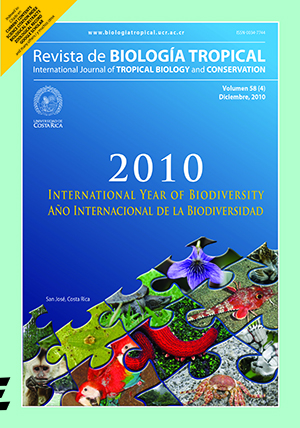Abstract
The lagoon complex of Cispatá (old Sinú river delta) located at the Northwestern coast of the Colombian Caribbean, encloses one of the biggest mangrove areas in this region. This area has changed during the last 330 years because of several environmental and climatic causes, mainly changes in the position of the delta (Sinú River), which is the main freshwater source in this area, and sea level rise. We hypothesized that the climatic and geomorphologic dynamics has caused changes in the extension and composition of mangrove vegetation, especially during last 150 years. The dynamics of mangroves during the last 900 years was reconstructed based on the changes in the stratigraphy, pollen record, calcite concentrations (CaCO3) and C/N ratio, along two sedi-ment cores from La Flotante and Navio lagoons, located in Cispatá complex. The age model was built based on lineal interpolation of 210Pb ages and changes in granulometry. Establishment and expansion of mangrove forests during the last 900 years were related to fluviomarine dynamics in the area and the lagoon formation. During the period encompassed between 1064 and 1762 A.D., the Mestizos spit was formed when marine conditions predominated in the surroundings of La Flotante Lagoon. At the site of Navío, a river dominated lagoon, ter-rigenous conditions dominated since 1830. Although the colonization of herbaceous pioneer vegetation started between 1142 and 1331 A.D., mangrove colonization only took place since 1717 A.D. Mangrove colonization was a result of the delta progradation. in1849 A.D. the Sinú river delta migrated to the Cispatá bay. The eustatic sea level rise, the increase in river discharges and sedimentation rates produced the establishment of mangrove forests dominated by Rhizophora since 1849. Since 1900 a marine intrusion was recorded in both lagoons. in 1938, the migration of the delta toward its actual location in Tinajones gave place to the formation of the present lagoon system and to the expansion of mangrove forests, which reflects the balance between the high alluvial sediment input and the current sea level rise as has been recorded in similar ecosystems.
##plugins.facebook.comentarios##

This work is licensed under a Creative Commons Attribution 4.0 International License.
Copyright (c) 2010 Revista de Biología Tropical






